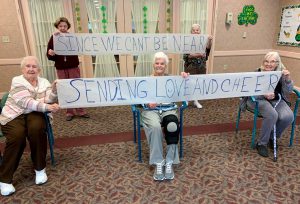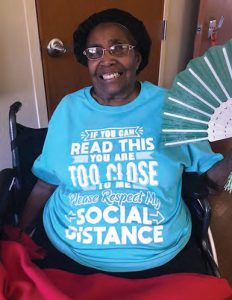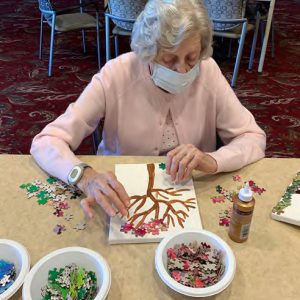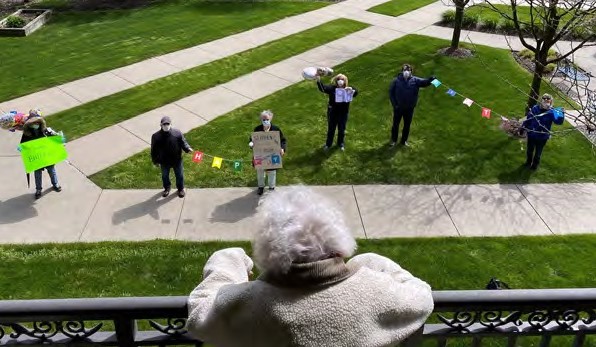COVID-19 has presented unique challenges for UPMC Senior Communities. Social distancing and self-isolation, while effective in limiting the spread of the novel coronavirus, can heighten feelings of loneliness, depression and anxiety, especially among older adults.

Finding new ways to communicate helped residents keep their spirits up.
The need to protect residents’ physical and mental health created opportunities for UPMC staff to reinvent how residents stay active and engaged.
Rethinking Established Methods of Care
UPMC Senior Communities operates nearly 30 facilities across Pennsylvania, encompassing independent living, personal care, memory care, assisted living and skilled nursing and rehabilitation. They are home to about 3,000 residents, many of whom are in their 80s and 90s, with varying needs.

A resident reminds those around her to maintain distancing.
Before the pandemic, residents regularly participated in group exercise and activities centered on music, art and learning. Off-campus bus trips to sporting events, parks, museums and theaters were a staple. Entertainers and volunteers visited frequently, and residents gathered informally for conversation and companionship.
Since March 2020, each facility has adapted to a “new normal,” rethinking the activities they offer and how residents interact with each other and their loved ones. It was not an option to keep residents confined to their rooms.
“We have to make sure we keep their spirits up. Keeping their minds active and engaged is extremely important,” said Christine Cassese, life enrichment coordinator at Cumberland Woods Village, an independent living facility. “We didn’t want them to feel stuck in front of their televisions.”

Residents at Cumberland Woods Village enjoy time outside.
COVID-19 forced group activities to be scaled back in terms of the number of participants. As much as possible, events and activities are held outdoors to better accommodate physical distancing.
Cassese implemented a “boredom buster” cart filled with books, playing cards, crossword puzzles and games like Sudoku, and residents could take what they wished.
Jeannine DeLuca, activities director at Seneca Place, a skilled nursing facility, put together packets for residents, complete with trivia, puzzles and mentions of significant events from that particular date in history, like the 1969 moon landing.
“Events they lived through and experienced firsthand have special meaning for them,” DeLuca said.

A resident and her family connect during a virtual visit.
Technology: Helping Us Stay Connected
Technology plays a critical role in keeping residents connected to their friends and families. Facilities purchased tablets for virtual visits with loved ones, and staff are readily available to navigate the devices for residents who are uncomfortable using technology on their own. Seneca Place recently coordinated more than 20 virtual visits for residents in one day.

Making puzzle tree art at Cumberland
Woods Village was one way for residents
to pass time.
Looking Beyond the Clouds
Cassese sees a silver lining in the COVID-19 cloud: Rethinking programming, activities and day-to-day operations during the pandemic was a necessity rather than an option, creating positive change.
The team’s ability to pivot and adapt throughout the pandemic has helped reinforce the notion that there are often new and better ways to make the residents’ golden years as fulfilling as possible.
“It’s forced us to be creative with what we offer and do, and to look beyond the clouds to see the rainbow,” she said. “It’s there somewhere — you just have to look for it.”








